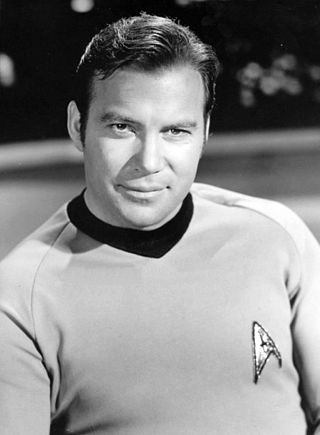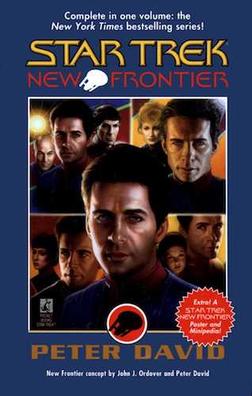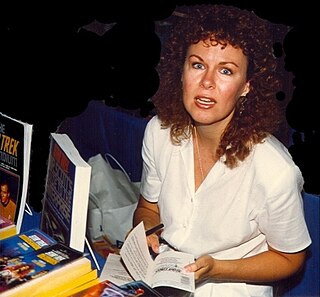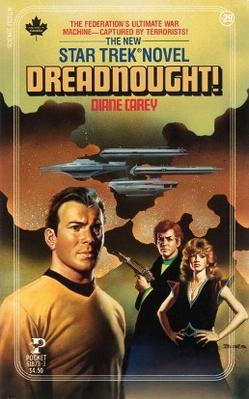
Star Trek II: The Wrath of Khan is a 1982 American science fiction film directed by Nicholas Meyer and based on the television series Star Trek. It is the second film in the Star Trek film series following Star Trek: The Motion Picture (1979), and is a sequel to the original series episode "Space Seed" (1967). The plot features Admiral James T. Kirk and the crew of the starship USS Enterprise facing off against the genetically engineered tyrant Khan Noonien Singh. When Khan escapes from a 15-year exile to exact revenge on Kirk, the crew of the Enterprise must stop him from acquiring a powerful terraforming device named Genesis. The film is the beginning of a three-film story arc that continues with the film Star Trek III: The Search for Spock (1984) and concludes with the film Star Trek IV: The Voyage Home (1986).

The Romulans are an extraterrestrial race in the American science fiction franchise Star Trek. They first appeared in the series Star Trek (1966–1969). They have appeared in most subsequent Star Trek releases, including The Animated Series, The Next Generation, Deep Space Nine, Voyager, Enterprise, Discovery, Picard, Strange New Worlds, and Lower Decks. They appear in the Star Trek feature films Star Trek V: The Final Frontier (1989), Star Trek VI: The Undiscovered Country (1991), Star Trek: Nemesis (2002) and Star Trek (2009). They also appear in various other spin-off media, including books, comics, toys and games.

James Tiberius Kirk is a fictional character in the Star Trek media franchise. Originally played by Canadian actor William Shatner, Kirk first appeared in Star Trek serving aboard the starship USS Enterprise as captain. Kirk leads his crew as they explore new worlds, new civilizations, and "boldly go where no man has gone before". Often, the characters of Spock and Leonard "Bones" McCoy act as his logical and emotional sounding boards, respectively. Kirk has also been portrayed in numerous films, books, comics, webisodes, and video games.

Spock is a fictional character in the Star Trek media franchise. He first appeared in the original Star Trek series serving aboard the starship USS Enterprise as science officer and first officer and later as commanding officer of the vessel. Spock's mixed human-Vulcan heritage serves as an important plot element in many of the character's appearances. Along with Captain James T. Kirk and Dr. Leonard "Bones" McCoy, he is one of the three central characters in the original Star Trek series and its films. After retiring from active duty in Starfleet, Spock served as a Federation ambassador, and later became involved in the ill-fated attempt to save Romulus from a supernova, leading him to live out the rest of his life in a parallel universe.

Star Trek III: The Search for Spock is a 1984 American science fiction film, written and produced by Harve Bennett, directed by Leonard Nimoy, and based on the television series Star Trek. It is the third film in the Star Trek franchise and is the second part of a three-film story arc that begins with Star Trek II: The Wrath of Khan (1982) and concludes with Star Trek IV: The Voyage Home (1986). After the death of Spock (Nimoy), the crew of the USS Enterprise returns to Earth. When James T. Kirk learns that Spock's spirit, or katra, is held in the mind of Dr. Leonard "Bones" McCoy, Kirk and company steal the decommissioned USS Enterprise to return Spock's body to his homeworld. The crew must also contend with hostile Klingons, led by Kruge, who are bent on stealing the secrets of the powerful terraforming device, Genesis.

Christine Chapel is a fictional character who appears in all three seasons of the American science fiction television series Star Trek: The Original Series, as well as Star Trek: The Animated Series and the films Star Trek: The Motion Picture and Star Trek IV: The Voyage Home. Portrayed by Majel Barrett, she was the ship's nurse on board the Starfleet starship USS Enterprise. A younger version of Chapel appears in the 2022 series Star Trek: Strange New Worlds, portrayed by Jess Bush.

Star Trek: New Frontier is a series of interlinked novels written by Peter David, published by Simon & Schuster imprints, Pocket Books, Pocket Star, and Gallery Books, from 1997 to 2015. New Frontier was the first Star Trek tie-in fiction property not to be based on a television series. The series was created by John J. Ordover.
The Sime~Gen Universe is a fictional literary universe created by Jacqueline Lichtenberg. It involves a future when humanity is divided into two subspecies, or larities: Gens, who look like ordinary humans and produce excess quantities of a life energy called selyn, and Simes, who have tentacled arms and must take selyn from Gens in order to survive. If the Gen is frightened and resisting when selyn is taken, the Gen dies. The series chronicles the history of the two subspecies' search for coexistence.

Kirk/Spock, commonly abbreviated as K/S or Spirk and referring to James T. Kirk and Spock from Star Trek, is a popular pair in slash fiction, possibly the first slash pairing, according to Henry Jenkins, an early slash fiction scholar. Early in the history of Star Trek fan fiction, a few fan writers started writing about a romantic and sexual relationship between Kirk and Spock, highlighting a romantic or sexual element to the friendship between the men. As of 1998, most academic studies on slash fiction focused on Kirk/Spock, as Star Trek was by that point one of the longest-lived and most prosperous subjects of slash fiction, while its mainstream popularity made it one of the most accessible titles for academics and their audience. As the first slash pairing, K/S was created and developed largely independently from the influence of other slash fiction, with most of the conventions of the slash genre seeing their debut first in K/S slash.

Jeanne Kalogridis, also known by the pseudonym J.M. Dillard, is an American writer of historical, science and horror fiction.

"The Expanse" is the fifty-second episode of Star Trek: Enterprise, the twenty-sixth episode of the second season, and the Season Two finale. The episode launched a change of direction for the series, starting with a cataclysmic attack on the Star Trek version of Earth and introducing a new alien foe, the Xindi.
The Kraith stories are a well-known set of early Star Trek fan fiction. The earliest entries were written by Jacqueline Lichtenberg starting in 1969. These continuing through the first few years after the cancellation of the first Star Trek series. The stories are named after the kraith, a goblet or chalice used in the performance of certain Vulcan rituals which feature prominently in several of the stories.
Michael Jan Friedman is a New York City born American author of nearly sixty books of fiction and nonfiction, more than half of which are in licensed tie-in products of the Star Trek franchise. Ten of his titles have appeared on the New York Times Best Seller list. Friedman has also written for network and cable television, radio, more than 150 comic books, most of them for DC Comics.

Dreadnought! is a Star Trek: The Original Series novel written by Diane Carey. It is written in the first person from the perspective of Lieutenant Piper.
A Mary Sue is a character archetype in fiction, usually a young woman, who is often portrayed as inexplicably competent across all domains, gifted with unique talents or powers, liked or respected by most other characters, unrealistically free of weaknesses, extremely attractive, innately virtuous, and/or generally lacking meaningful character flaws. Usually female and almost always the main character, a Mary Sue is often an author's idealized self-insertion, and may serve as a form of wish fulfillment. Mary Sue stories are often written by adolescent authors.
Robert Greenberger is an American writer and editor known for his work on Comics Scene, Starlog, Weekly World News, the novelization of the film Hellboy II, and for the executive positions he held at both Marvel Comics and DC Comics. He also served as an elected office holder in his home of Fairfield, Connecticut.

The development of Spock, a fictional character first introduced in the American science fiction television series Star Trek, began prior to the start of the series. The first known mention of Spock was in a discussion between Gene Roddenberry and Gary Lockwood, where the latter suggested Leonard Nimoy for the role. Roddenberry agreed with the suggestion, and Nimoy became the first choice actor for the part. However, Roddenberry was required to audition other actors for the role. It was offered to both DeForest Kelley and Martin Landau before Nimoy. Nimoy disliked the prosthetic ears he was required to wear, and there were concerns from the studio that they made him appear satanic. Roddenberry fought to keep the character in the second pilot, "Where No Man Has Gone Before" after the rest of the main cast was dropped from the initial pilot, "The Cage".
Camille Bacon-Smith is an American scholar and novelist. She has a Ph.D. in folklore and folklife from the University of Pennsylvania. Her books, Enterprising Women (1992) and Science Fiction Culture (1999), investigated science fiction fandom, including such aspects as slash fiction, hurt-comfort stories and Mary Sue characterization. Under her own name she has published an urban fantasy series beginning with Eye of the Daemon (1996). Under the pen name Curt Benjamin, she has written fantasy novels with an Asian setting, beginning with The Prince of Shadow (2001). In 2016 she began writing dance reviews for Broad Street Review, an online publication on Philadelphia arts and culture.












